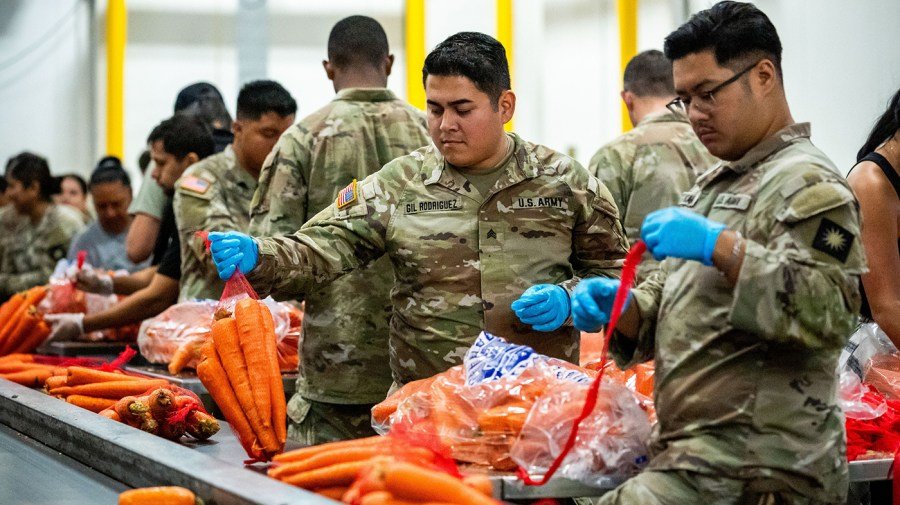
Thousands of military families who receive government benefits are facing a food insecurity cliff with uncertainty over funding for the Supplemental Nutrition Assistance Program (SNAP).
Two federal judges on Friday ordered the Trump administration to tap into billions of dollars in emergency funds to at least partially cover food stamp benefits for more than 42 million Americans in November, but that will not cover all of the needed payments for the month.
Trump late Friday signaled he would provide moneys from the emergency fund, but he asked the courts for direction on how to legally do so.
The uncertainty could plunge thousands of service members — particularly younger troops who can sometimes struggle to cover the cost of living with their lower paychecks — into crisis.
“We’re hearing in real time stories from families that are incredibly alarming,” said Kara Pappas, chief advancement officer of the nonprofit Military Family Advisory Network (MFAN).
Pappas, a military spouse herself, said her organization is being contacted by families that are already living paycheck to paycheck, particularly junior enlisted families, or those with the Guard or Reserve “who are often without the same access to base resources and have been the first to miss pay during these disruptions.”
Though the Trump administration has managed to cobble together the funds necessary to make sure active-duty and mobilized National Guard and Reserve troops receive their end-of-the month paychecks Friday, it might not cover all household costs for many families thanks to a variety of factors.
One major issue is that many military spouses, an estimated 27 percent, are also employed by the federal government and could be facing furlough, meaning families that might be used to having two incomes are down to only one.
Other families that are mobilized with the Guard or Reserve have reported discrepancies with pay in the last midmonth pay period, according to Eileen Huck, deputy director of government relations for the National Military Family Association, a nonprofit.
“These are people who are mobilized away from their civilian job, potentially not getting paid in their Reserve job and have families at home that they’re worried about, whether they’re going to be able to put food on the table,” Huck told The Hill. “It’s definitely been a very stressful time.”
Compounding issues, military families rely on support and services provided by federal civilian employees who may be furloughed. In the case of pay discrepancies for troops, Huck said she would ordinarily advise people to call their installation finance office, “but if those people are furloughed, there’s no one for families to go to to investigate why there might be an issue with their pay.”
It’s unclear exactly how many service members are enrolled in SNAP — which provides food benefits to low-income families to supplement their grocery budget — but 1 in 4 military households are food insecure during normal government operations, according to data from the U.S. Department of Agriculture (USDA) as well as MFAN.
A 2020 Pentagon report found that between 880 and 4,620 military members received SNAP benefits, but a similar report released five years earlier placed the figure as high as 22,000.
Dried up food assistance will also greatly impact veterans, with more than 1 million found to be food insecure but only two-thirds of that population signed up for benefits like SNAP, according to a 2023 study by Rand Corp.
What’s more, many troops and military families that aren’t enrolled in any food assistance programs frequently use military and local food banks to make ends meet. Such resources are quickly becoming overwhelmed the longer the shutdown drags on.
The Armed Services YMCA nonprofit told ABC News last week that it was seeing a 30 percent or more rise in demand at its locations near bases.
Service members might get some relief after federal judges in Massachusetts and Rhode Island rejected a USDA claim that an emergency fund of $5.3 billion could not help cover SNAP benefits, but only hurricanes or other uncontrollable catastrophes, as the government shutdown nears a month.
But although the USDA was ordered to distribute the emergency funds “timely or as soon as possible” and provide an update to the court by Monday, the money does not cover the full $9 billion needed for SNAP payments in November.
“That’s all trickling down to having to make impossible choices. Do I make a car payment, or do I put food on the table?” Pappas said.
She detailed to The Hill first-hand accounts from service members struggling with the effects of the shutdown, including one family sitting on $29,000 in credit card debt after a permanent change of station from California to North Carolina right before the shutdown. The family members had to fund their own move but haven’t yet been reimbursed and are not sure when or if will come, Pappas said, noting that half of all military families under those conditions experience food insecurity.
MFAN, which already runs a pantry restock program for any military family moving bases — providing $150 worth of food and goods under normal circumstances — retooled the initiative upon the shutdown to offer emergency grocery support shipped directly to military families.
Pappas said the organization opened an application process in mid-October and within 72 hours had 50,000 military families that had applied for the support.
“It far outpaced our expectations about the need and really was alarming and heartbreaking all at the same time,” she said.
MFAN had to put a pause on accepting new applications to the program after the first 72 hours “but we are continuing to hear from families daily who are wanting to be added to the wait list,” Pappas added.
She said the nonprofit has deployed more than 5,000 emergency grocery support boxes to families and are working through the line, but the organization itself is running out of funding to provide for every family on the waitlist.


